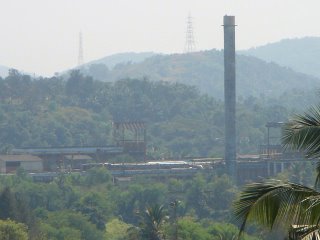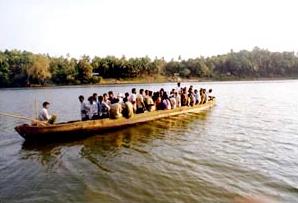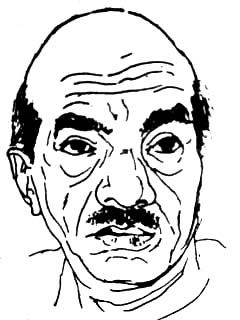This is version One-Dot-One, added some essential links. As always whenever you read something that you have written long back, you always get the feeling that "how can I write so stupidly". But then I didn't make any modifications to the original post.
Thudakkam:
 Rewind back to the end of 1950's... a time when the world saw that communism can indeed come to power through ballot. A great visionary became the chief minister and some path breaking decisions were made. One among them was to invite some of India's corporate big-wigs to invest in Kerala. And, perhaps the only time in the history of "united" Kerala, some of them actually came forward and invested some big money. And the biggest by far was the Birlas and their GRASIM.
Rewind back to the end of 1950's... a time when the world saw that communism can indeed come to power through ballot. A great visionary became the chief minister and some path breaking decisions were made. One among them was to invite some of India's corporate big-wigs to invest in Kerala. And, perhaps the only time in the history of "united" Kerala, some of them actually came forward and invested some big money. And the biggest by far was the Birlas and their GRASIM.Tucked away in the banks of the most beautiful Chaliyar, 20km away from the heart of Calicut city, bordering Malappuram, was a small hillock called Mavoor. This was the place that the Birlas chose for their Pulp and Fibre factory. Mainly, because of the plentiness of water, closeness to Nilambur - from where the facory will get all its wood and bamboo, and lots of uninhabited free land. Work started towards the end of 50's continuing through the early 60's. Being the first pulp and fibre factory (technically speaking, first Rayon grade pulp and viscose staple fibre (VSF) factory) in the country, Birlas got world class engineers from Sweden and Norway to supervise the construction. The earliest employees where Keralites who were working in the steel plants of north (Bhilai, Durgapur, Rourkela etc), lured here by the handsome salary and a chance to work so close to their homes.

As my Valiachan(one of the earliest employees), often recounts, it was a tough task. First there was no proper road connecting Calicut city and Mavoor. So the Birlas had to first built that road. And thus came into being, which is still, Calicut's most important and busiest road... the Mavoor Road. Next, there were something else to take care of... Snakes!. There were lots of them, if the ones on the ground were not enough, snakes of all sizes and shapes flowed in through the river. I remember, my Valiachan telling how they all had to wear huge boots to avoid snake bites!
Production started in 1963. By then, Grasim was one of the most important firms in Kerala. These were the best paid jobs. Best technicians and engineers of the land were here. Everything went very well for the first 20 years. There was a saying that, the merchants in SM Street will wait for the day when Grasim will pay out the bonus. Not only the pay, the employees got some excellent perks as well. State of the art clubs-houses and play grounds. Free water and electricity (so much so that every household used only electric heaters for cooking ... Nobody cared for gas). Bus sevices to fetch their children to the colleges in the town and back. And not to ever forget, one of the best schools in the entire district. I believe we were one of the first people in the entire state who watched cable TV!. Mavoorians were one privileged lot...And arrogant too in that. Maybe god was watching this arrogance!...
go to ... PART II, PART III

8 comments:
Anish !
I am reading your Oru Deshethinte Katha and I am happy to note that you have high regards for your Velliachhan . But let me correct you on some basics about the Mavoor Rayons Factory !
No Swedish or Norwegians Engineers set foot on Mavoor soil before my father Koyapathodi Mohamed Kutty Sahib (KM KUtty Sahib ) as he was called.He built the factory in 1961 when RN Saboo terminated the work unilaerally and the BIRLAS failed to clear the construction costs.They started production even before clearing the builder and then your norwegian or swedish engineers came and started the pulp manufacturing process without completeing the pollution control norms of discharging the waste water right upto the sea at Feroke !
Thats how the Beautiful clear waters of the Chaliyar got polluted and I remember in my childhood we could clearly see the fish in the water.
Well those were the days !
Anyway let me read your other chapters-this was a correction to Part 1.
If you get in touch by EMail I can show you some old correspondance and photographs. I do have a lot of small b/w pictures of the construction work of 1960's at Madras.
Hope to hear from you
Best of Luck to you Anish
Muneer (now in the gulf)nribahrain@gmail.com
Anish !
I am reading your Oru Deshethinte Katha and I am happy to note that you have high regards for your Velliachhan . But let me correct you on some basics about the Mavoor Rayons Factory !
No Swedish or Norwegians Engineers set foot on Mavoor soil before my father Koyapathodi Mohamed Kutty Sahib (KM KUtty Sahib ) as he was called.He built the factory in 1961 when RN Saboo terminated the work unilaerally and the BIRLAS failed to clear the construction costs.They started production even before clearing the builder and then your norwegian or swedish engineers came and started the pulp manufacturing process without completeing the pollution control norms of discharging the waste water right upto the sea at Feroke !
Thats how the Beautiful clear waters of the Chaliyar got polluted and I remember in my childhood we could clearly see the fish in the water.
Well those were the days !
Anyway let me read your other chapters-this was a correction to Part 1.
If you get in touch by EMail I can show you some old correspondance and photographs. I do have a lot of small b/w pictures of the construction work of 1960's at Madras.
Hope to hear from you
Best of Luck to you Anish
Muneer (now in the gulf)
Hello Muneerkka,
Thanks for reading my post!. And do correct me on wherever I went wrong. I only have "kettarivu" on all stories of the 60's.
Will definitely mail you. I am very eager to see all those old photographs.
Thanks,
Anish
Thanks Sam!
Anish,
I am doing a project on this topic and i need some literature. Can you please help?
Can you please let me know your contact email?
Thanks!
Saurav - saurav1202@gmail.com
Anish!
Very good write up. when I was reading through remind me the chaliar in which i took bath and swim accross every day after playing foot ball.
It also remember the chlorine leak from the factory while I was on my way to mavoor to fetch fish from the market. Thank god!!. It would have been another Union carbide. It is good that the capatilist had gone and people had settled well where ever thay are.
I do remmber the lathi charge during the strikes where i lost my bycycle key while dodging police men and had to carry it on my shoulder during odd hours in the night.
Even though I had to leave mavoor for better prospects I am glad that movoorians has show to the world that people of mavoor will survive with out any help from capitalist. We have defeated them for our mavoor and people of mavoor.
-Capt. jayaprakash
hello friends.. as i am a new gen from mavoor i was eagerly searching for the past history of mavoor... thanks for having this writeup.. if anyone knows more than this about pollution, grasim history , people, production ,strikes , environmental problems etc please mail to my id : basithmavoor121@gmail.com
Great work . I feel nice while i reading blog .You are doing well. Keep it up. We will also provide
Buy Heart Care Kadha Online
Post a Comment